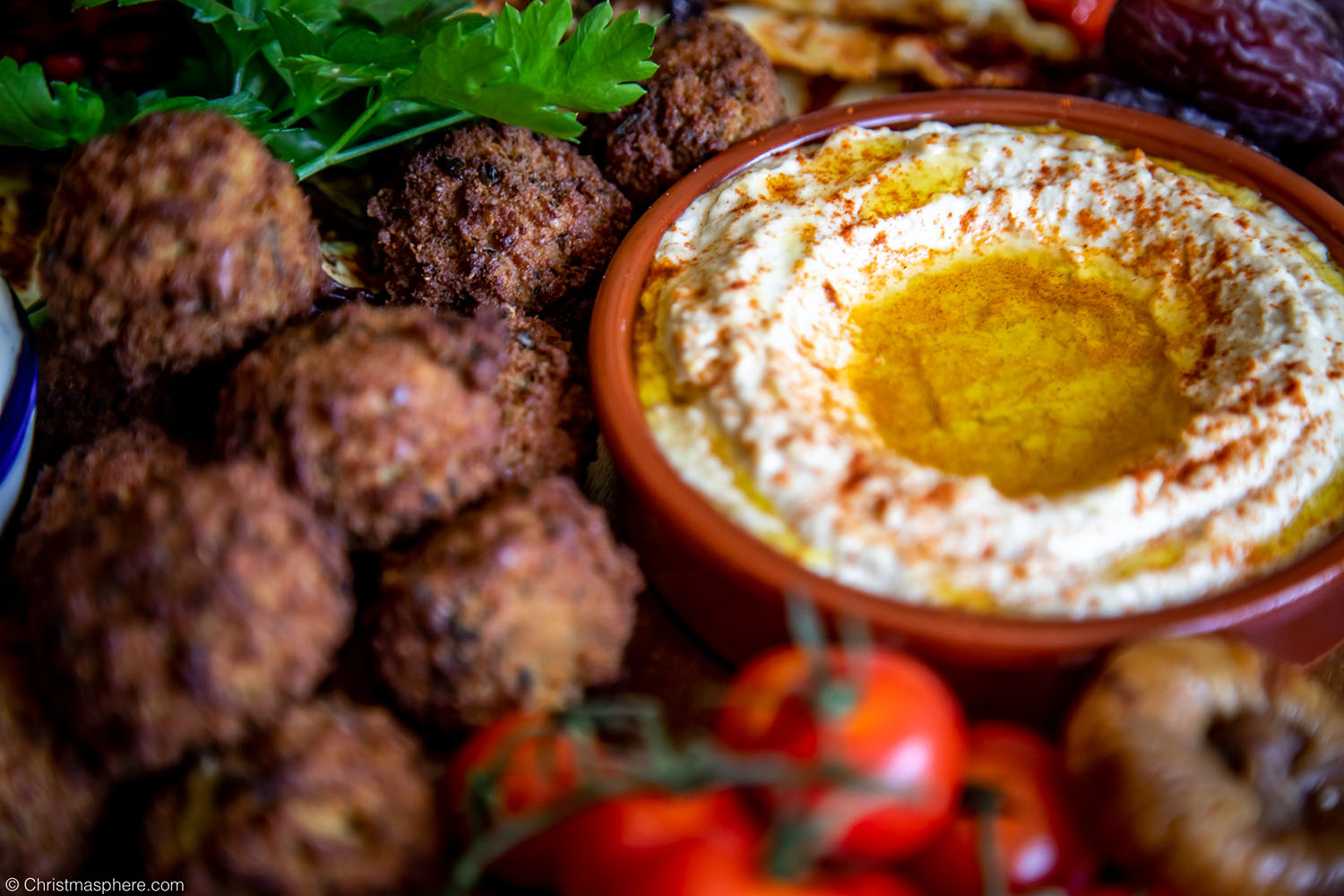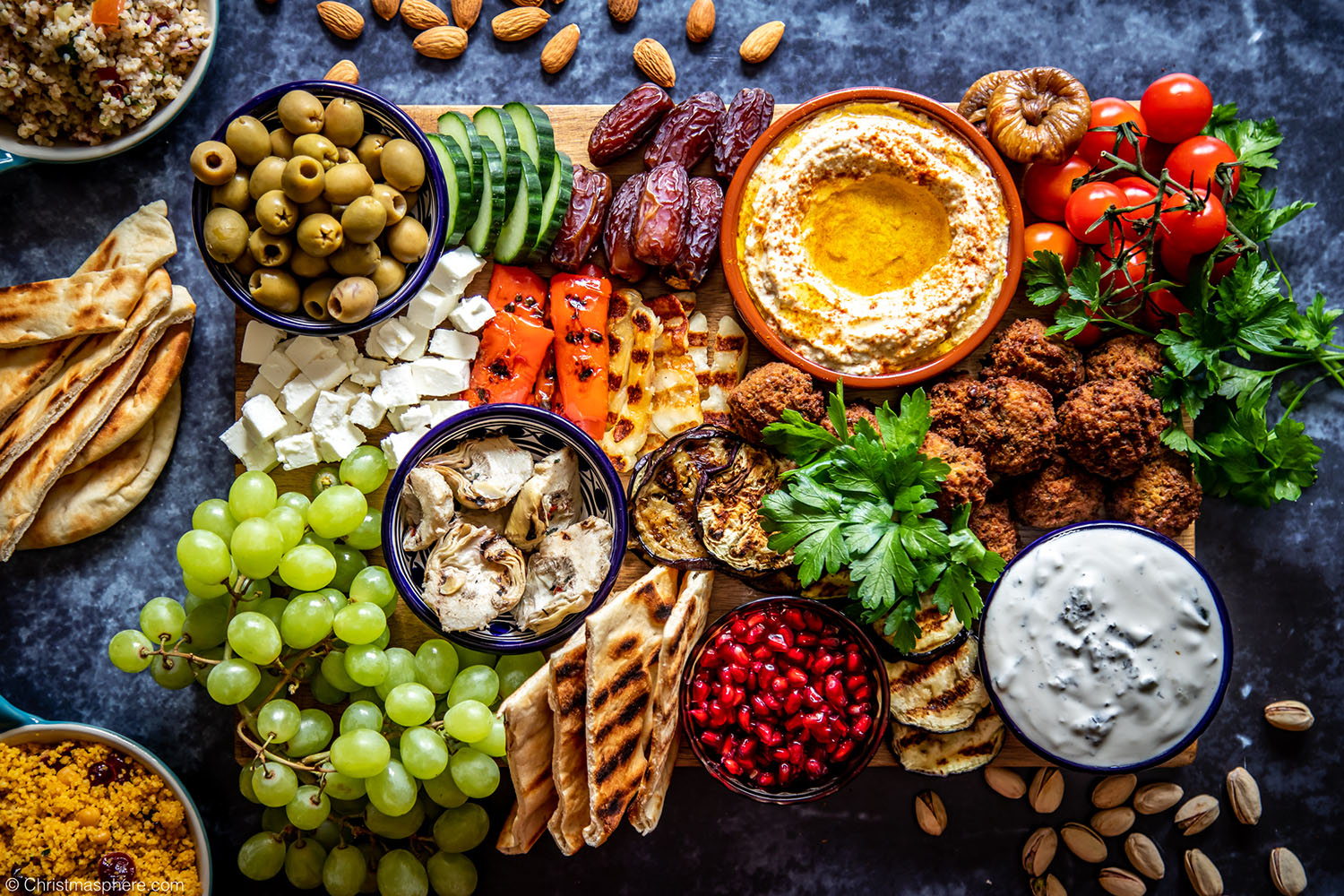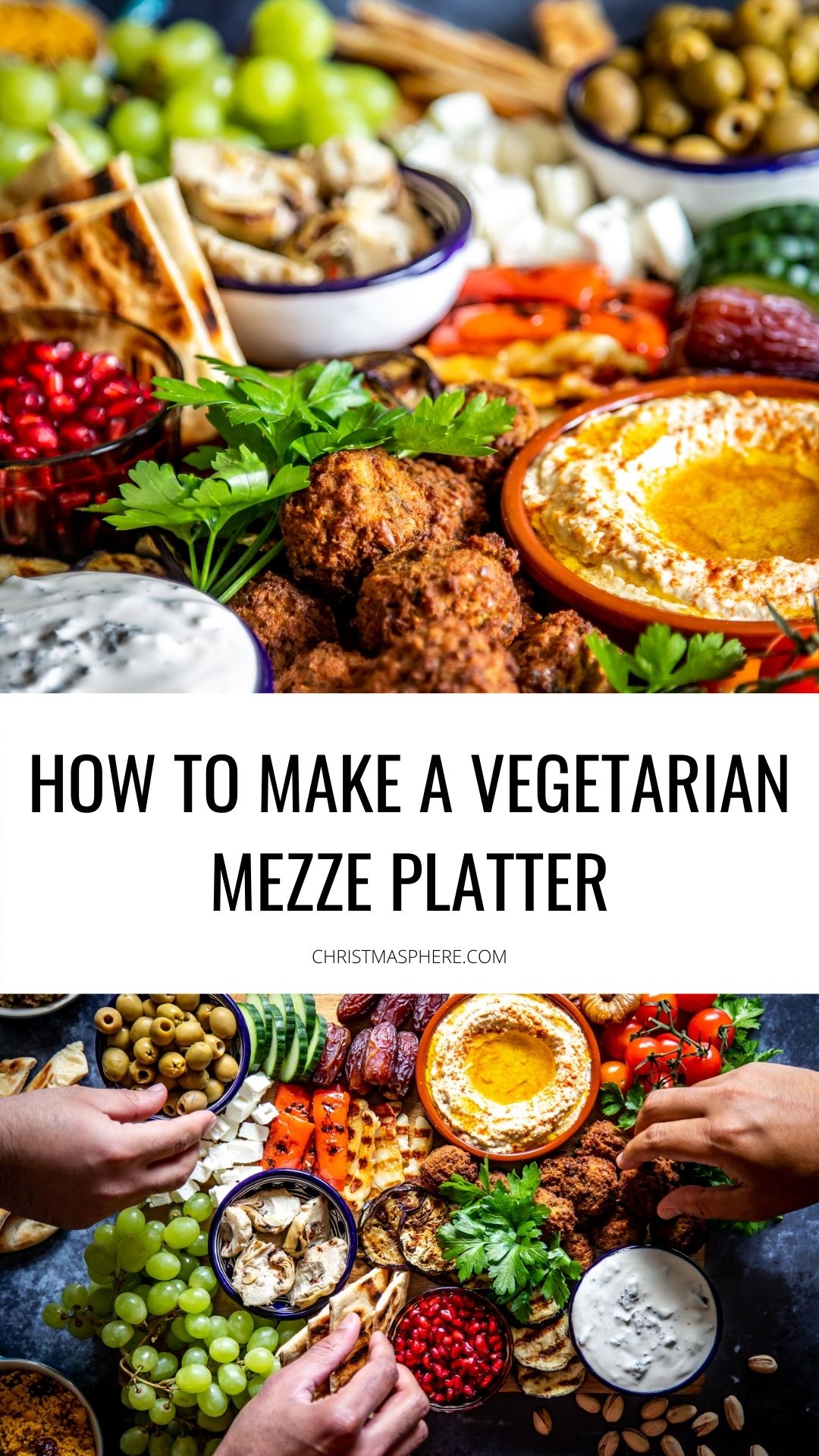Sharing food is such a sociable activity. Food has the power to bring people to cover, it encourages conversation as well as fills our bellies! We are big fans of sharing food platters here at Christmasphere HQ. There are so many different options for creating food boards.
We have chosen to share how to make a vegetarian mezze platter today. But other ideas could include a cheese platter, Greek mezze platter, Middle Eastern platter, charcuterie board, falafal platter, a Christmas-themed platter.. the options really are endless. This was so much fun to prepare, eat and share – it’s almost like vegetarian tapas, casual eating at it’s finest.

What is in the Vegetarian Mezze Board?
We chose to make a vegetarian mezze board for our guests that included a great range of flavours, textures, and colours to make for both a pretty-looking lunch dish, and something for everyone to make up a plate with.
In our vegetarian mezze board we included falafel, grilled halloumi, grilled aubergine, artichokes, peppers, feta cheese, dates, figs, pomegranate, grapes, cherry tomatoes, cucumber, olives, houmous, tzatziki, two types of couscous salads, almonds, pistachios, and flatbreads.
The beauty of choosing a vegetarian mezze board is that you can choose whatever you like to add to the board, choose what food is in season or local to you, and consider what works best for your guests. This is a vegetarian grazing board at its finest! And a great alternative for vegetarian starters for your guests.
Of course, meat can be include in mezze boards, but in this instance we wanted a vegetarian mezze platter. Read on for veggie platter ideas!
How to assemble the vegetarian mezze board
The base
It is all about having a good base for your mezze board. Any food platter wants to be wide enough to safely hold all the elements of your food. Traditionally you might go for a large, flat wooden chopping board. These look attractive to serve food on, and even as the nibbles get eaten the board looks good as it is revealed underneath.
If you are choosing a lot of foods that might ‘roll’ you may need a tray-style food platter with sides to stop anything rolling away. Nobody wants to see an errant grape rolling across the floor! An enamel-tray would look lovely for a grazing board.
If you want to keep it convenient you could use a disposable foil tray, or a plastic board. We have even some some people use fresh rolls of brown paper spread out along a long table or countertop.
And if you would like a more luxe look go for a marble chopping board or glass board.
The assembly skills
Tools for your vegetarian mezze board:
- Small pots for dips and smaller foods such as nuts and olives
- Cheese knives for each type of cheese
- Cutlery, choose something lovely if it’s a special occasion
- Napkins, you’ll want plenty of napkins for everyone eating
How to serve the grazing board for guests
There are a couple of factors to think about when serving your food platter for your guests. Firstly, the size of your food board might dictate whether you need to assemble the board ‘in situ’ because if it is large, or the food is heavy, it might be more difficult to pick it up and move it to the table for guests.
Secondly, you need to think about how guests are picking food off the mezze platter. Will you be providing side plates for them to eat from? Or do you want to keep it simple with just napkins?
Is the food platter being served around a table with guests seated? Or is it a more casual affair on a kitchen island and guests standing and socialising whilst picking at the food?
The key elements of a food platter
Food platters usually have the following elements:
- Cheese (usually a soft, semi-soft, and hard option)
- Cured Meats (usually a variety of flavours and textures)
- Condiments (this includes spreads, jams, chutneys)
- Dips (these tend to be eaten in larger quantities than the condiments)
- Nibble-y Bits (ranging from nuts and olives to sundried tomatoes anything you find on a deli counter)
- Carbs (provide a variety of textures, think crackers, breadsticks, bread)
- Fruits (usually a combination of fresh and dried options)
- Veggies (offer a range of textures, colours, and flavours)
- Garnish (make the board look pretty with bunches of fresh herbs, flowers, leaves)
What other foods can you add to a mezze platter in general?
Cheese
- Cheddar
- Edam
- Brie
- Camembert
- Feta
- Goat’s
- Manchego
- Gouda
- Pecorino
- Wensleydale
- Gruyéye
- Mozzarella
Fruits
- Grapes
- Figs
- Dates
- Apricots
- Raisons
- Strawberries
- Raspberries
- Blueberries
- Blackberries
- Apples
- Pears
- Pomegranate
Vegetables
- Cherry Tomatoes
- Cucumber
- Red and Orange Peppers
- Carrots
- Sugar Snap Peas
- Babycorn
- Avocado
- Celery
- Radish
- Mushrooms
- Aubergine
Cured Meats
- Prosciutto
- Serranon Ham
- Chorizo
- Honey-Roasted Ham
- Salami
- Calabrese
- Pepperoni
Nibble-y Bits
- Nuts – pistachios, cashews, peanuts, pecans, walnuts, macadamias, hazelnuts, almonds, smoked and sweet versions,
- Olives – stuffed and unstuffed
- Sundried Tomatoes
- Feta-stuffed Tomatoes
- Grilled Artichoke Hearts
- Pickled Onions
- Pickled Beetroot
- Cornichons
- Dolmades
- Honeycomb
Bread/Crackers
- Water Crackers
- Melba Toast
- Sea Salt Crackers
- Rosemary Crackers
- Multigrain Crackers
- Crostini
- Bread sticks
- Baguette
- Toasted Ciabatta
- Pitta Bread
- Flatbreads
- Foccacia
Dips
- Houmous
- Baba Ganoush
- Guacamole
- Tabouleh
- Raita
- Yoghurt
- Salsa
- Onion dip
- Whipped feta
- Taramasalata
- Olive Tapenade
- Olive Oil and Balsamic Vinegar
Spreads and Condiments
- Paté
- Rilletes
- Fois Gras
- Honey
- Chilli Jam
- Damson Jam
- Onion Chutney
- Fig Spread
- Mustard
- Bransons Pickle
- Spiced Apple Chutney
- Beetroot Chutney
Garnish
- Fresh Herbs – parsley, coriander, basil, rosemary, thyme, chives
- Edible Flowers – nasturtium, viola, pea flowers, chive flowers, coriander flowers, borage, cornflower, pansy, lavender, elderflower, hibiscus, calendula, rose
- Salad Leaves – rocket/arugula, spinach, oak leaf lettuce
Does this mezze board meet any specialist dietary requirements?
The great thing about making your own mezze board is that you can choose what food ingredients to use, so if you do need to meet any dietary requirements or allergies you can adapt as necessary.
If there is an allergy amongst the guests that might severely hamper your mezze platter you could perhaps make up a smaller platter just for them that omits the food they cannot eat.
VEGETARIAN MEZZE PLATTER (SERVES 8)
INGREDIENTS
- Falafal
- Halloumi
- Feta
- Aubergine
- Red Pepper
- Cherry Tomatoes
- Cucumber
- Pomegranate
- Artichokes
- Olives
- Dates
- Figs
- Grapes
- Pistachios
- Almonds
- Couscous
- Pitta Bread
- Flatbreads
- Houmous
- Olive Oil
- Ground Paprika
- Tzatziki
- Parsley
METHOD
- Start by slicing all over the vegetables that will served raw such as cucumber, red pepper.
- Tip the dips and olives into small bowls and place on the board in different places.
- Arrange the raw ingredients such as the fruit, vegetables, cheeses, and nuts around the edges and dip bowls.
- On a griddle cook the halloumi, aubergine, flat breads and arrange on board.
- Arrange the the herbs in any of the gaps left on the mezze board.
- Serve any extra dishes such as the couscous salads in bowls around the mezze board.
We hope this helps you give you some veg platter ideas!
How To Make a Vegetarian Mezze Board

There are so many different options for creating food boards. We have chosen to share how to make a vegetarian mezze platter today. But other ideas could include a cheese platter, Greek mezze platter, Middle Eastern platter, charcuterie board, falafal platter, a Christmas-themed platter.. the options really are endless.
Ingredients
- Falafal
- Halloumi
- Feta
- Aubergine
- Red Pepper
- Cherry Tomatoes
- Cucumber
- Pomegranate
- Artichokes
- Olives
- Dates
- Figs
- Grapes
- Pistachios
- Almonds
- Couscous
- Pitta Bread
- Flatbreads
- Houmous
- Olive Oil
- Ground Paprika
- Tzatziki
- Parsley
Instructions
- Start by slicing all over the vegetables that will served raw such as cucumber, red pepper.
- Tip the dips and olives into small bowls and place on the board in different places.
- Arrange the raw ingredients such as the fruit, vegetables, cheeses, and nuts around the edges and dip bowls.
- On a griddle cook the halloumi, aubergine, flat breads and arrange on board.
- Arrange the the herbs in any of the gaps left on the mezze board.
Notes
Food platters usually have the following elements:
- Cheese (usually a soft, semi-soft, and hard option)
- Cured Meats (usually a variety of flavours and textures)
- Condiments (this includes spreads, jams, chutneys)
- Dips (these tend to be eaten in larger quantities than the condiments)
- Nibble-y Bits (ranging from nuts and olives to sundried tomatoes anything you find on a deli counter)
- Carbs (provide a variety of textures, think crackers, breadsticks, bread)
- Fruits (usually a combination of fresh and dried options)
- Veggies (offer a range of textures, colours, and flavours)
- Garnish (make the board look pretty with bunches of fresh herbs, flowers, leaves)





You might also like:













